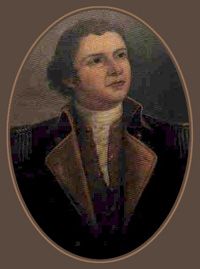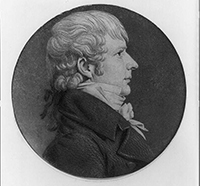
Many people know Hugh Mercer’s role in Fredericksburg as a doctor and would expect him to have also played a major role at St. George’s. However it was his son, called Hugh Tennent who upstaged his father at St. George’s. The older Mercer’s career was cut short by his service in the Revolution War and his death at the Battle of Princeton in 1777.
Hugh Mercer (1726-1777) was born in Scotland and studied medicine at Marishal College at the University of Aberdeen. He was an assistant surgeon in the abortive rising against the English culminating in the Battle of Culloden, an effort to depose King George II and restore the House of Stuart with Bonnie Prince Charlie. After the battle he fled to Green Castle, PA. Despite the earlier dealings with the British, Mercer would offer services to the British after the disastrous defeat of General Braddock in 1755 in the French and Indian War. He met and cultivated Washington who was fighting under General Forbes who would take the French fort of Duquesne, later renamed For Pitt and which became Pittsburgh.
After the war Mercer settle in Fredericksburg from Feb., 1761 until Feb., 1776 when he dissolved his medical expense and began efforts for preparing troops in the Northern Neck. He was attracted to Fredericksburg, a town of 3,000, due to his friendship with George Washington and relationship with his future brother-in-law as well as friend George Weedon. Richard Starling suggests in his undergraduate thesis on Mercer that he had an active life. “Here Mercer accumulated property, doctored the elite, got married and raise a family and became a prominent citizen.” He first lived in a tavern which was kept by John Gordon. It was there he became friends with George Weedon.
He established a medical practice in 1763 and then raised funds to establish the Apothecary shop in 1771 with Dr. Ewen Clements. It was common at the time for a doctor to combine his medical practice with an apothecary, an outlet for medicines. The earlier medical location is not known but near the intersection of what is Amelia and Caroline Street. The original apothecary shop is no longer in existence but was about a half block away [The current apothecary shop building was dated in 2000 to between 1771 and 1772 using dendrochronology using 15 wood samples from the building. Since there was no evidence of insect activity common to oak when stored for more than one year the assumption is that the current building was built in the same time frame and is illustrative of the type of shop he may have operated. Jenny Strobel wrote an article for the Free Lance-Star about the apothecary practice in 2001].
He did not appear to have held any Parish offices at St. George’s during his time in Fredericksburg. He naturally came here since the law required attendance. Starling cites evidence that Mercer did help sponsor a lottery to raise funds for a church renovation 1769. His name appears in the Vestry minutes 1767-1775.
During one time of the year usually fall, the Vestry would estimate the total expenses (budget today) and to “lay the parish levy” upon each tithable. Each tithable would be each male white person and every black person, male and female, above the age of 16. The levy would be collected by the following April either by the local sheriff or other collector.
From this number the expenses would be allocated to tithables and paid by them. In the time of Mercer in 1769 the minister would be paid 16,000 pounds of tobacco as well as other church officials from the parish. In 1769, that would include the Rappahannock Church, Mattaponi and Pamunkey churches.
Services provided to the church would be paid in pounds, shilling and pence. Mercer provided services and so the amounts are listed. Between 1767-1775 he provided services and was paid on his account at first by tobacco and then by pounds, shilling and pence.
The following were the entries found. Note the purpose was not recorded so it is not evident from the minutes what services he provided. Starling reports that one of the expenses was due to expenses for an indigent citizen:
02/17/1767 Paid 3,000 as per account
01/27/1768 Collectors to pay him $1,000 in tobacco
12/18/1769 Pay account 30 .14.6
10/01/1770 15.11.6 paid per account
03/12/1772 6.18. 0 by account
12/16/1772 Dr. Hugh Mercer & Clements by Acct 9.5.0
10/23/1775 Mess Mercer & Julian 21.8.
Mercer had five children, four sons and a daughter. The daughter Anna married Robert Patton. A later Patton was General George Patton.
 Mercer’s son, Hugh Tennent Mercer, Jr. (1776-1853) first appears in St. George’s Vestry Minutes in 1804 and 1809 to collect subscriptions. This was a time when the church was most in needs of funds with the flow of people away from the church after the disestablishment of the Church of England. He was also on the Vestry by 1809 since he is listed as a warden.
Mercer’s son, Hugh Tennent Mercer, Jr. (1776-1853) first appears in St. George’s Vestry Minutes in 1804 and 1809 to collect subscriptions. This was a time when the church was most in needs of funds with the flow of people away from the church after the disestablishment of the Church of England. He was also on the Vestry by 1809 since he is listed as a warden.
He was a trustee of the church by April 27, 1812 and was one of the delegates to the convention in Richmond. Mercer, Zach Lewis, John Smith, W. S. Stone, and Dabney Herndon were appointed as committee to raise funds by subscription for repairs of church and return results by May 16, 1812.
In a trustees meeting on Jun 12, 1812, they said they found “so general a disposition in the inhabitants to build a new church in preference to repairing the old one.” A congregation meeting was held on June 17 to resolve the issue. Mercer along with William Bernard, Williams S. Stone and Benjamin Day would be responsible for managing the raising of funds to build a new church.
It was not until December 21, 1813 that a group of 23 met to consider the details of a new building. Presumably the interim was spent in fund raising. 6 were elected as a Commissioners to “fix the site of the church” and to contract for the work.
Mercer was on the Vestry in Feb. 21, 1814 that the Trustees and the Commissioners would join to guarantee the work. The sale of the pews would be the ultimate source of repayment. Mercer and seven others were appointed to sell church items and to receive subscriptions for the new church.
By Nov. 1814, the building apparently was proceeding so that they could now raise subscriptions for the support of Rev. McGuire as the minister and the building. Subscriptions would be collected based on the town organization into four wards.
By March 15, 1815, there were cost overruns. Earlier, in Sept, 1814, the trustees agreed to apply for a $1,500 loan to the Farmers Bank for construction. $2,000 was now needed to borrow for the galleries and the plastering of the church. This request was likely made to the Bank of Virginia. In April they would advertise in the newspapers for additional subscriptions.
By Oct. 16, 1815 the pews were to be advertised – single pews not under $100 and double pews not under $200. The purchasers could borrow on credit for “three and six months.” Costs now to be covered include the painting the inside and the doors and shutters. Any surplus would go back to the subscribers in relationship to their original subscription.
We know little of the inside of the second church. There were at least 2 side galleries, 2 doors leading to them and an organ gallery and at least two doors, presumably on the outside of the church. There was also a bell. The organ would be take from the first church and “put in complete repairs.” They would reserve the seats on the “right and left of each door of the galleries” for the “People of Colour.”
Mercer continued to serve on the Vestry when the Vestry minutes end in 1817. They were meeting at the courthouse or homes in 1816 which could indicate a lack of a meeting room (Faulkner Hall had not been built) or an unfinished church although it had been consecrated. They took up issues of the convention of the Episcopal Church in Virginia. Apparently one was discipline in the church and the suspension of certain canons. While certain canons (numbers 6 and 7) they agreed in suspending, they were opposed to trials of “supposed offenders” which could cause a rift in the church. They supported looking to the Holy Spirit and conscience as the best ways to proceed.
His last recorded act was to write a letter to the Mayor and Council that the sexton be employed to ring the bell for town functions and that he would be paid for doing so.
Mercer participated in many civic events outside of St. George’s. In May 1819 Mercer chaired and addressed the meeting that created the American Colonization Society branch at St. George’s for Fredericksburg, leading to the adoption of a constitution as well as a committee to obtain additional subscribers.
In 1823, he was president of the Fredericksburg Classical Academy. At the time there were 30 pupils primarily studying Greek and Latin. (Serving with him was Rev. McGuire). He was also trustee of another school, the Female Charity School in 1823 at a time when they lamented the “impoverished state of the funds). They appealed to the public for additional contributions to “feed and clothe and educate indigent female children, who, but for its protection would be left to idleness and ignorance and vice.” He served that group as early as 1807 as a trustee.
He served on the committee preparing for Lafayette’s visit in 1824 and 10 years later as a pallbearer in a local funeral for Lafayette
Over a period from 1817 until 1851 he served as a director for Bank of Virginia.
He died in 1853 and the funeral was at the Presbyterian. He may have been one who switched to that church in the 1830’s when the current Presbyterian Church building was established. (He left the Vestry in 1829). He is buried in the Fredericksburg Cemetery.
